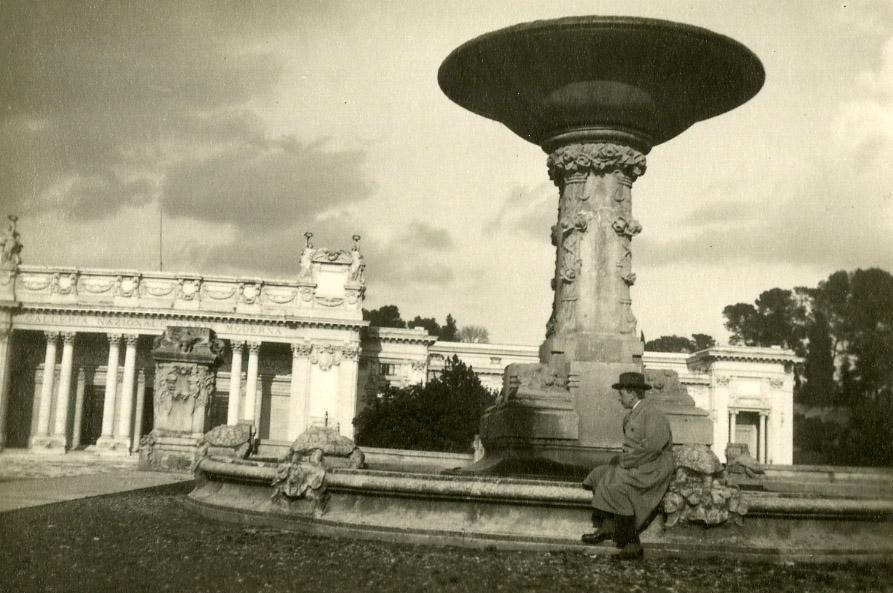Digitization. It’s not the sexiest of words, and one which does not reveal the enormity of its significance. It does not disclose how it brought Asta Nielsen and Poul Reumert to dance close together, how it facilitated a trip to Mars, or how Valdemar Psilander can now clown around on computer screens, mobiles, and tablets worldwide. How is the analogue strip transformed into a digital stream? Let’s take a journey with the editor of stumfilm.dk and find out.
Anne Schwartz, Project Editor | 30 September 2020
It’s dark and freezing cold. We can see our breath in the air as the fluorescent tubes cast a harsh light across the spartan interior. There’s grey concrete everywhere you look, and the heavy, anonymous steel doors of a similar greyish hue give nothing away as to what’s behind them.
If you didn’t know, it would be difficult to imagine that we’re in a treasure trove of Danish film history – an underground bunker at an unknown address in Store Dyrehave.
If you drive along the Hillerød motorway and turn onto the small forest road, you’ll reach a clearing between the trees on the left, where the grass surface is perforated by black square boxes in straight rows. A huge entrance penetrates down into the terrain, leading to the elusive steel door that marks the entrance to the highly revered Nitrate Archive. Here, every preserved Danish silent film is kept at -5 degrees and 30% humidity to protect as well as possible the material, which is divided into small cells. These old strips are as flammable as petrol. Should an accident occur, the exhaust system – the black boxes on top of the bunker – ensure that the fire won’t spread to neighbouring rooms.
Jan, the film archive’s driver, and I are here to collect the next series of films to be brought to life by the huge digitalisation machinery in the manned archive in Glostrup. One of the titles we’ve come for is Mists of the past (Fra Piazza del Popolo) from 1925.
Big movies in times of adversity
“At one time, Nordisk Films Co. was at the forefront of film pioneers on the global stage. Step by step, it is now seeking to regain lost ground,” wrote Magasinet on 3 May 1925, rubbing salt in the polar bear’s wounds. Things had only gone downhill since the First World War. The nationalisation of German film production forced Nordisk Film to sell all its German branches, and when Hollywood took the world by storm, the polar bear had a hard time keeping its proud position on top of the globe.
With its new senior director A.W. Sandberg at the helm, through the 1920s Nordisk Film sought to regain its former status as a major player in the international market with large-scale literary film adaptations. However, the success enjoyed by the Swedes with their national classics did not materialise. A.W., as he was known, went for gold with a number of film adaptations of Charles Dickens’ novels before turning, in 1925, to Vilhelm Bergsøe’s classic about a colony of Scandinavian artists in golden-age Rome.
Mists of the past was predicted to be “a film that will fill cinemas across Denmark and the world night after night this winter”. It wasn’t to be.
Rome wasn’t built in a day... It was built in Valby
The film is deposited in a chiller in the film archive in Glostrup. Despite our intense curiosity, it’s not possible to see the material immediately. It has to acclimatise before we can even take it out of its tin. After the chiller, it continues on its way to a coolbox at +5 degrees, and then the film, which is spread over several spools, must be left at room temperature for at least 24 hours before the fragile material can see the light of day in 2020.
While the film is tempering, I delve into the archive of images and find preserved photographs from footage that testifies to the ambitions and money invested in the film. Beautifully composed scenes – some of them based directly on such well-known paintings as Danish artists at the Osteria La Gensola in Rome by Ditlev Blunck and The people of Copenhagen on their evening walk before the Great Prayer Day by Andreas Herman Hunæus – and hundreds of extras in costumes to match 19th-century Rome. Some of the outdoor scenes were shot on location in the Roman residential area of Frascati, while the rest took shape among the opulent scenery in and around Nordisk Film’s studios in Valby. Here, as elsewhere, Rome was certainly not built in a day. An entire collection of photos from decorative painter Carlo Jacobsen’s research trip to Italy also bears witness to the hard work that went into the film.
“He has erected whole neighbourhoods of historic Rome and narrow alleys where coquettish little Italian women look through green shutters, and the matriarchal carabinieri patrol back and forth in front of picturesque stalls, piazzas with their columns, pigeons and depictions of the Virgin Mary, and the rugged old ruins where thistles and brambles grow in the cracks,” wrote Aftenposten in its report from the recordings on 29 June 1925.
It’s quite impossible not to look forward to seeing Rome in Valby in moving images.
A first glimpse
There’s still a long way to go before the scanner brings the film to life. The strip must go through a spool table where it’s manually checked for physical defects – things like small cracks that could break the strip, or glue splices from 1925 that are so fragile they could disintegrate. We also check that this is the material we want. Every little thing must be checked and repaired before the film continues on its journey through the machinery.
Wearing white gloves, I’m allowed to hold the strip up to the light. In the small transparent images, I recognise Olaf Fønss in the role of the poor Norwegian sculptor Olaf Malm, the main character of the story. The year is 1820 and he, like many other Scandinavian artists of the Golden Age, has travelled to the Italian capital in the hope that in this mecca of sculptural art he would find inspiration and make a name for himself. He is overwhelmed by the city’s beauty and loses faith in his own abilities.
That is, until sawmill owner Olaisen, who has paid for his stay, arrives with his wife and his daughter, Sigrid, Olaf’s childhood friend. Romance, which has long bubbled under the surface, now comes to the fore and Olaf sculpts a “psyche” with his beloved’s features, which her father immediately orders in marble. Sigrid is allowed to sit and model, and their love grows by the day.
I’m familiar with the story of the preserved film, and I know that this is not going to go well for them.
A much-needed bath
It’s time for the cleaning machine to shine... literally. The rollers are inserted into a cabinet similar to a spool table with an upright plate of glass. Behind the screen, the film is passed from one spool to another, while a special kind of alcohol loosens the dirt and dust, which is then washed off when the strip is passed between two rotating sponges.
It is meditative and oddly satisfying to watch the lengths that my colleagues and these high-tech machines go to. I’m told that the market for these cleaning machines is so niche that they are only made to order. Although this is hardly surprising, it says something about just how specialised the work of digitalising Danish silent movies is.
The best and latest machinery for the oldest movies
415 titles, 350 hours, 47,690,140 frames. The silent films that Nordisk Film and other Danish production companies made in the early 1900s took a maximum of one to two weeks to produce. Now, 100 years later, they are being treated with the utmost care and are undergoing a long and arduous journey from bunker to screen.
It’s simply fascinating to think of all the steps that each film – which is on several different rolls in the case of a feature film – has to go through, and all the expert hands and minds that follow it painstakingly on its way.
And the amount of data is breathtaking – a single frame takes up 65 MB. And 65 times 47,690,140 adds up to a number that my iPhone calculator doesn’t even have room for. It needs to be converted to gigabytes, terabytes, and then petabytes. I’ve never been good at maths, but the point is that these preserved silent films, which of course take up a lot of physical space, make up a mind-boggling amount of data once scanned.
A.W.’s 95-year-old Piazza del Popolo has finally reached the Arriscan XT – an impressive piece of German kit that fills almost an entire room. It can scan 35 mm film in 4K resolution. “It’s the best and the latest available,” says the scanner operator, Nikolaj, as he fires up this beast of a machine.
On a screen in the adjacent room, I watch as Arriscan photographs a single image per second. This slow speed makes it possible to closely study the artistic texts, or “intertitles”, that intersperse the images. Mists of the past used what are known as “art titles” – intertitles designed by an artist especially for the film. To allude to the plot, the texts are written on a canvas in a font that matches the style and expression of the film. The artistry of these intertitles is once again testament to the financial resources of the production. To attract an international, cultured, and affluent audience, the film employed on-location shots from Italy, actors such as Olaf Fønss and Karina Bell, and detailed scenography and art titles. In addition, the ornate composition of scenes from well-known paintings was all part of the mission to lure the right kind of people to the cinema.
Night or day?
It probably doesn’t occur to most people that the vast majority of silent films were in colour. When Nordisk Film started production in 1906, it was quite common to colourise films in one way or another. A film cost DKK 1 per metre. A colourised version cost an extra DKK 0.10 per metre. One of the colourisation methods used was tinting. “This is a process by which the film strip was immersed in a dye bath during copying. The result was that the parts of the strip that would have been white in a black and white copy were now in the desired colour,” explains film researcher Marguerite Engberg in the article “Er det nat eller dag” in Kosmorama no. 198 from 1991.
The tints often reflected the context. Day scenes were yellow or amber, night scenes were blue, and fire scenes were red. The sections of the film that contained night scenes were cut out, joined together, and immersed in a blue dye bath (using quite ordinary cotton dye from the textile industry), after which they were then separated again and inserted back into the correct places in the film. When films could be played with sound, colourisation disappeared as the soundtrack of the film strip could not work with tinted film.
The preserved original nitrate copy of Mists of the past from 1925 is black and white, the material being digitalised is a tinted copy from 1999 that museum inspector of the Danish Film Institute Thomas Christensen restored for a screening at the silent film festival in Pordenone. “It’s not the case that we’ve gone in and picked some colours at random. We’ve looked up the original analogue index cards with precise descriptions of the colour of each individual scene. It’s a time-consuming and laborious process, but it’s the only way to recreate an experience that’s as close as possible to what audiences saw at the cinema in 1925.”
In pursuit of an authentic cinema experience
Historical authenticity weighs heavily in the restoration of silent films. Digital tools allow for a restoration that removes all scratches and graininess and adjusts light levels and sharpness, leaving you with wonderfully sharp images. But that’s not the objective.
“We consider this type of remastering to be a commercial venture that aims to trick the audience into believing that what they’re seeing is an original and completely flawless silent film. And that’s just not how they looked,” explains Thomas. When the objective is to recreate the original cinema experience, it’s important not to over-restore.
Like all other silent movies, Mists of the past must be colour-corrected, as the colours have faded over the years. This takes place in the archive’s working cinema, where colour grader Jørgen Christiansen works on the files from the scanner. “Colour grading silent films isn’t the same as colour grading a newly produced film. You have to know the background, and you have to know your colour-grading theory. You must be careful not to manipulate the colours into something that didn’t exist at the time,” explains Jørgen while concentrating and gently turning the special adjustment wheels that change the yellowish tone of the canvas in front of us.
When I step into the restoration suite a few weeks later, they’re working on the film’s wild action sequence in which the Tiber has broken its banks and is flooding large parts of Rome. The main character, Olaf, has heroically thrown himself into the water to assist with the rescue efforts, all while restoration technician Claus Greffel removes the stains and flaws from every single frame here in Glostrup in 2020. “We’ve no problem with a film looking a little old and worn. We just don’t want there to be things that affect the cinema experience,” he says, once again emphasising the importance of historical authenticity.
Mists of the past has 114,916 individual frames, and Claus must look at each and every one of them.
Fortunately, special software can help with the heavier work, removing most of the dust and scratches before Claus makes the finishing touches. Each film throws up new challenges because each film is unique. “If a problem arises that we’re unable to solve, we send documented images to the programmers in Austria, who then write completely new software to solve that specific problem,” explains Claus.
The film’s sensational flood scene was created using a miniature mode of the district over which water was poured. Were it not for the unnaturally large droplets in the crests of the waves, it would actually look quite realistic. Ironically, digitalisation has made it obvious that the Roman facades and streets are actually a miniature world made from papier maché.
When Harriet becomes Thora
“Still dreaming of your lover, eh? Well I think you can make up your mind you will never see him again,” says Olaisen to his devastated daughter, whom he has promised to a rich Englishman.
Before the film undergoes a final review so that it can be remastered for streaming on stumfilm.dk and kept on the archive’s enormous server, the intertexts must be translated into Danish. At one time the preserved copy was exported to the UK or the US, because the texts are in English. The original Danish intertexts were neatly written down by diligent office workers (probably women) at Nordisk Film just so that they could be efficiently translated for export.
The Danish intertexts must be entered manually, and despite this being essentially monkey work, it appears that many people are needed to interpret the handwriting and that some ethical and creative choices have to be made in relation to the translation itself. A good example is the issue of names, in that the names of the characters often change depending on which country the film was to be shown in. In English-speaking countries, for example, Harriet became Thora. Should the name be translated back to the original Danish, or does it confuse the viewer to read “Harriet” in the subtitle and “Thora” on the screen?
In addition, there are often major discrepancies between the original and the translated intertexts, as it seems that translators were given free rein. Ultimately, the most important thing is that the overall meaning comes across, and that the wording is up to date. And from time to time we’re treated to such gems as “Don’t go mad, neighbour. Look, there are hemp seeds for the canary!”
Digital premiere
Ten weeks have passed since Jan and I collected Mists of the past from the bunker. It has been repaired, cleaned, scanned, colour-corrected, restored, and remastered.
And today A.W. Sandberg’s 95-year-old-film gets its digital premiere to an audience in 2020. Although the film did not have the international impact Nordisk Film envisaged, Danish reviewers were impressed and had the following praise for the director:
“Although he is wary of contemporary films, allow him to go back a couple of generations and give him crinoline, calfskins, curls, and other forgotten glories to play with, and he is in a completely different class up among truly world-class directors.”
All that’s left to do is press play.
Anne Schwartz, Project Editor | 30 September 2020
Mists of the past: From strip to stream
Follow A.W. Sandberg’s 1925-blockbuster through the archive machinery.
Produced by Daniel Bødker Sørensen, 2020.
Speak: Liv Thomsen, Historieselskabet.
Mists of the past: Behind the scenes





Contact

|
Anne Schwartz Project editor + 45 3374 3681 annesc@dfi.dk |
||||||||||

|
Thomas C. Christensen Curator +45 3374 3576 thomasc@dfi.dk |
||||||||||

|
Jørgen Christiansen Project Manager, digitization +45 3374 3623 jorgenc@dfi.dk |
||||||||||

|
Claus Greffel Digital restoration technician +45 3374 3405 clausg@dfi.dk |
||||||||||
